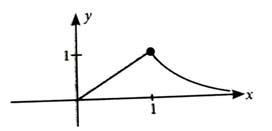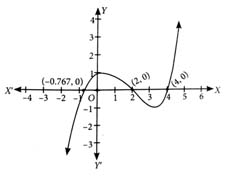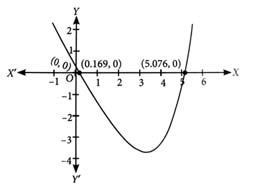Topic Question Set
Q 31
:
Consider the function defined by . If and be respectively the number of points at which is not continuous and is not differentiable, then is [2024]
1
0
2
3
(1)

Given,
is continuous everywhere for but not differentiable at
Thus,
Hence,
Q 32
:
Let If and are respectively the number of points at which the curves and intersect the axis, then the value of is _________. [2024]
(5)
We have,

By graph, since intersects the -axis at 3 points. So, number of solutions of
Also,

By graph, since intersects -axis at 2 points. So, number of solutions of
Thus,
Q 33
:
Let be a twice differentiale function such that (sin x cos y)(f(2x + 2y) – f(2x – 2y)) = (cos x sin y)(f(2x + 2y) + f(2x – 2y)), for all x, y R.
If , then the value of is : [2025]
–3
–2
3
2
(1)
We have,
(sin x cos y)(f(2x + 2y) – f(2x – 2y)) = (cos x sin y)(f(2x + 2y) + f(2x – 2y))
f(2x + 2y) sin (x – y) = f(2x – 2y) sin (x + y)
Put 2x + 2y = m and 2x – 2y = n, we get
Now,
.
Q 34
:
Let be continuous at x = 0. Then is equal to : [2025]
48
72
36
64
(1)
L.H.L. =
R.H.L. =
Since, f(x) is continuous at x = 0
Right hand limit exists
... (i)
Now,
[Using L'Hospital's Rule]
[From (i)]
Now,
.
Q 35
:
If , then is equal to [2025]
–1
27
1
28
(1)
We have,
y(x) = sin x (28 – 27) – cos x (27 – 27) + (sin x + cos x + 1)(27 – 28)
y(x) = – cos x – 1
On differentiate w.r.t. x, we get
.
Q 36
:
Let be a continuous function satisfying f(0) = 1 and f(2x) – f(x) = x for all x R. If , then is equal to [2025]
540
420
385
215
(3)
We have, f(2x) – f(x) = x
On adding all the above statements, we get
.
Q 37
:
Let f(x) be a real differentiable function such that f(0) = 1 and for all x, y R. Then is equal to : [2025]
2406
5220
2525
2384
(3)
When x = 0, y = 0, we have
When y = 0,
[ f(0) = 1]
Integrating both sides, we get
Now,
.
Q 38
:
If the function is continuous at x = 0, then is equal to [2025]
20
5
10
8
(3)
... (i)
;
... (ii)
Adding (i) and (ii), we get
.
Q 39
:
Let [x] denote the greatest integer function, and let m and n respectively be the numbers of the points, where the function , is not continuous and not differentiable Then m + n is equal to : [2025]
7
8
6
9
(2)
Given :
The function can also be written as follows:
Here, function f(x) is not continuous at x = –1, 0, 1 and 2.
Hence, function f(x) is not differentiable at x = –1, 0, 1 and 2.
So, we have m = n = 4.
m + n = 4 + 4 = 8.
Q 40
:
Let the function be not differentiable at the two points and . Then the distance of the point from the line 12x + 5y +10 = 0 is equal to : [2025]
4
3
2
5
(*)
We have,
Now, cos |x| is always differentiable
So, we will check for and it is not differentiable at its roots.
It is given that
The other root of .
Note: There is error in question, f(x) is differentiable at x = 1.

